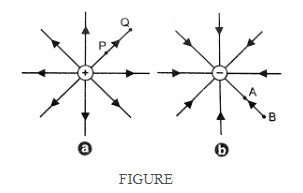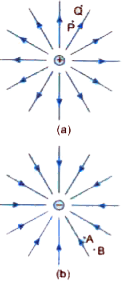Figures (a) and (b) show the field lines of a positive and negative point charge respectively

(a) Give the signs of the potential difference VP−VQ,VB–VA.
(b) Give the sign of the potential energy difference of a small negative charge between the points Q and P, A and B.
(c) Give the sign of the work done by the field in moving a small positive charge from Q to P.
(d) Give the sign of the work done by the external agency in moving a small negative charge from B to A.
(e) Does the kinetic energy of a small negative charge increase or decrease in going from B to A?
As V∝1r∴Vp>vQor(VP−VQ) is positive
Also VB is less negative than VA
(∵ distance fo B is more than distance of A)
Thus, VB>VA∴(VB−VA) is positive.
(b) A negative charge held at Q would move towards P. As charge moves from higher potential energy to lower potential energy ∴(P.E)Q>(P.E)P
Therefore, sign of potential energy difference of a small negative charge between Q and P is positive. Similarly , (P.E)A>(P.E)B
Sign of potential energy difference is positive.
(c) In moving a small positive charge from Q to P, work has to be done by us against the electric filed. Therefore, work has to be done by the field is negative.
(d) In moving a small negative charge from B to A, work done by external agency is positive.
(e) Due to force of repulsion on the negative charge, velocity decreases and hence K.E. decreases in going from B to A.
Topper's Solved these Questions
- ELECTROSTATICSBOOK - PRADEEPCHAPTER - ELECTROSTATICSEXERCISE - SHORT ANSWER QUESTIONS
9 Videos
- ELECTROSTATICSBOOK - PRADEEPCHAPTER - ELECTROSTATICSEXERCISE - CURIOSITY QUESTIONS
4 Videos
- ELECTROSTATICSBOOK - PRADEEPCHAPTER - ELECTROSTATICSEXERCISE - TYPICAL EXAMPLES
1 Videos
- ELECTRONIC DEVICESBOOK - PRADEEPCHAPTER - ELECTRONIC DEVICESEXERCISE - Fill in the Blanks
1 Videos
- MAGNETIC EFFECT OF CURRENT AND MAGNETISMBOOK - PRADEEPCHAPTER - MAGNETIC EFFECT OF CURRENT AND MAGNETISMEXERCISE - Competition Focus (Multiple Choice Questions)
2 Videos
Similar Questions
Figures (a) and (b) show the field lines of a positive and negative point charge respectively

(a) Give the signs of the potential difference VP−VQ,VB–VA.
(b) Give the sign of the potential energy difference of a small negative charge between the points Q and P, A and B.
(c) Give the sign of the work done by the field in moving a small positive charge from Q to P.
(d) Give the sign of the work done by the external agency in moving a small negative charge from B to A.
(e) Does the kinetic energy of a small negative charge increase or decrease in going from B to A?
View SolutionFigure (a) and (b) show the field lines of a positive and negative point charge respectively.

(a) Give the signs of the potential difference . Vp−VQ,VB−VA
(b) Give the sign of the potential energy difference if a small negative charge is moved from points Q to P from point A to B.
(c) Give the sign of the work done by the field in moving a small positive charge from Q to P.
( d) Give the sign of the work done by the external agency in moving a samall negative charge from B to A .
(e ) Does the kinetic energy of a small negative charge increase or decrease in going from B to A ?
View Solution
Knowledge Check
The potential difference (VA−VB) between the point A and B in the given figure is
 A+6VB+9VC−3VD+3V
A+6VB+9VC−3VD+3V
Fig (a) and (b) show the field lines of a single positive and negative charges respectively .
Give the signs of the potential difference : VP−VQ,VB−VA

View SolutionFig (a) and (b) show the field lines of a single positive and negative charges respectively .
Give the sign of the work done by an external agency in moving a small negative charge from B to A .

View SolutionFig (a) and (b) show the field lines of a single positive and negative charges respectively .
Does the kinetic energy of a small negative charge increase or decrease in going from B to A ?

View SolutionFig (a) and (b) show the field lines of a single positive and negative charges respectively .
Give the sign of the potential energy difference of a small negative charge between the points Q and P , A and B .

View SolutionFig (a) and (b) show the field lines of a single positive and negative charges respectively .
Give the sign of the work done by the field in moving a small positive charge from Q to P .

View SolutionFigure shows the field lines of a point negative charge. In going from B to A, the kinetic energy of a small negative charge will

View Solution‘A point charge +Q is placed at point O as shown in the figure. Is the potential difference VA–VB positive.

View Solution
